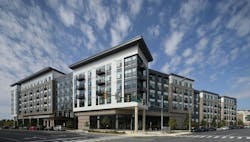An Innovative Financing Model for Affordable Housing
North of Washington, D.C., and southwest of Baltimore, Montgomery County in Maryland represents both ends of the country’s economic divide. It’s one of the country’s wealthiest counties—and also a county where about one-fifth of households make less than $50,000 a year.
But for decades, the county has been at the forefront of affordable-housing innovations. For instance, Montgomery was the country’s first county to require developers of large apartment buildings to reserve some units for affordable housing.
Still, in Montgomery County, as elsewhere, the demand for affordable housing far exceeds the available federal resources. “The typical finance sources of affordable housing are largely federal and finite—they get used each year. And they’re insufficient,” says Zachary Marks, senior vice president, the Housing Opportunities Commission (HOC) of Montgomery County, which was formed 50 years ago to provide affordable housing.
Now, HOC is taking advantage of a different kind of funding model, the Housing Production Fund (HPF)—a winner of the 2024 Ivory Prize, which honors innovations in housing affordability. In 2021-22, Montgomery County Council approved the $100 million HPF, which HOC uses to finance construction of publicly owned, mixed-income, and mixed-use developments.
Ivory Prize Winner Helps Bring Affordable Housing to Maryland
The revolving fund will support the construction of 6,000 new residential units over the next 20 years, and 1,800 of the units (or 30%) will be designated as affordable housing—permanently. Among the income-restricted units, 20% are affordable at or below 50% of the area median income (AMI), and the other 10% at or below 65%-70% of the AMI.
“HPF is a new tool in our toolkit to accelerate the production of affordable housing without relying on the typical resources available to build affordable housing,” says Chelsea Andrews, president and executive director, HOC. “The concept is to leverage a mixed-income model where market-rate units offset the costs of affordable units.”
With the fund, HOC replaces private equity as both the building owner and as developers’ main source of investment, while charging the developers lower interest rates. “We stand in for private equity,” Marks says. “So instead of a private equity firm as the owner calling all the shots and driving the need for high returns over every other possible goal, HOC is in that role, and we’re able to prioritize affordable housing.”
For developers, HOC, and residents, it’s a win-win-win situation, Andrews says. “The developers have the ability to leverage low-cost capital. We get the expertise of private developers who build highly attractive, luxury developments that will forever be affordable and that we own,” she says. “And the residents are able to live in beautiful, highly amenitized properties that are very close to mass transportation.”
The HPF’s first completed project, The Laureate, which opened last year, provides 268 residences ranging from studios to three-bedroom units—including 188 units at market rate and 80 affordable. (Of the affordable units, 67 are at 50% AMI and 13 at 70% AMI.)
The Laureate belies any usual connotations of “affordable housing.” It offers an outdoor heated pool, multipurpose maker space, fitness studio, children’s playroom, pet spa, common area with a fireplace, clubroom with a movie theater, and underground parking and bike storage. “It’s a beautiful living space that everyone feels proud to call home,” Andrews says.
Including The Laureate, seven projects have been approved to use the HPF—maxing out the $100 million fund.
Now, jurisdictions across the country are exploring how they can adapt a similar model. State and federal housing authorities are in conversation with HOC to learn how they can engage in similar public-private partnerships to create more affordable housing. “We talk to our partners across the country about how to make HPF fit in their community,” says Andrews, noting that Maryland recently passed a housing innovation fund that draws on the HPF model.



